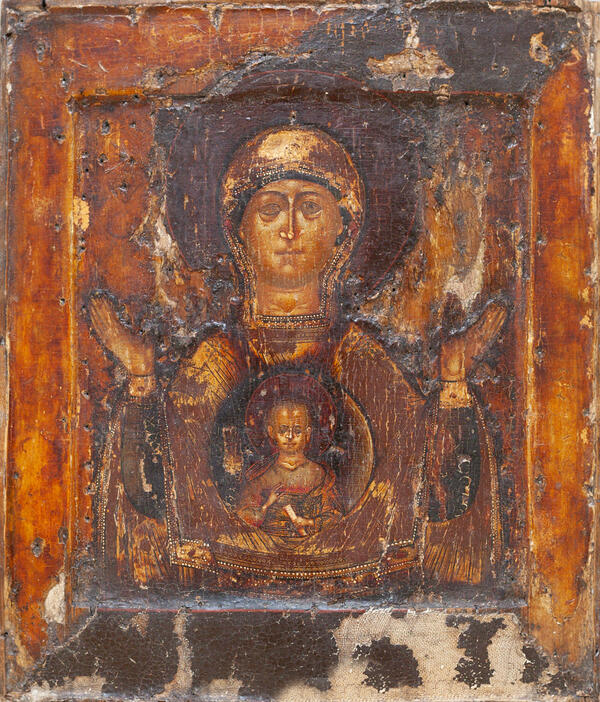The icon of the Mother of God known as the iconographic type “Our Lady of the Sign” depicts Virgin Mary with her hands raised in a prayer. On her chest is a medallion with Christ Emmanuel holding a scroll and blessing. This depiction is one of the earliest iconographic images.
The appearance of this type of icon in Siberia is associated with the name of the first tsar of the Romanov dynasty — Michael Fyodorovich. In 1620, he established the Tobolsk Diocese in the Siberian Governorate. Its first archbishop was Cyprian, who came from the Khutyn Monastery of Saviour’s Transfiguration in Veliky Novgorod. For centuries, “Our Lady of the Sign” remained the most beloved sacred icon and the main intercessor (defender) of the Novgorodians: more than once it protected the city and its inhabitants from all kinds of misfortunes.
The icon of the Virgin “Our Lady of the Sign”, which is housed in the Tomsk Museum, was created at the end of the 17th — early 18th century. It almost exactly repeats the features of the famous Novgorod original: the position of Mary’s figure, her gestures, and the shape of the maforium (long cloak). The Christ Child is represented as an adult, he even looks quite severe. The gravity of the image is achieved by angular-sharp features created by rigid lines of white paint, and by the line of Christ’s tightly compressed lips. The faces are painted in predominantly golden-brown tones. The white paint on the bridge of the nose of the Mother of God was used to create a special highlight (“ozhivki” in Russian) — a glare that makes the image look three-dimensional.
Christ’s light olive chiton (tunic) with a dark girdle is decorated with lines of gold leaf and silver. In iconography, this method is called the technique of gold assists: gold leaf lines were usually applied over the folds of robes, feathers, wings of angels, domes and other details of the image. The assists symbolize the presence of divine light in the icon. The maforium and the chiton of the Mother of God are outlined with oxidized silver. Icon painters use it to imitate gold: thin silver leaves are blackened in a special way, so that a unique color is developed which is similar to darkened gold and characteristic of old icons.
The style of painting and the quality of materials indicate that the image was created in Tobolsk by masters who had received great training. The use of darkened silver for decoration of the robes of the Virgin Mary allows researchers to assume that the icon was repaired by a 19th-century master-restorer from Moscow. Mstyora is a village in Vladimir Oblast, which is famous for its icon painters. Archival documents of the 18th — 19th centuries repeatedly mention ‘icon painters from Vladimir’ who depicted local churches, created and ‘restored old images.’
The appearance of this type of icon in Siberia is associated with the name of the first tsar of the Romanov dynasty — Michael Fyodorovich. In 1620, he established the Tobolsk Diocese in the Siberian Governorate. Its first archbishop was Cyprian, who came from the Khutyn Monastery of Saviour’s Transfiguration in Veliky Novgorod. For centuries, “Our Lady of the Sign” remained the most beloved sacred icon and the main intercessor (defender) of the Novgorodians: more than once it protected the city and its inhabitants from all kinds of misfortunes.
The icon of the Virgin “Our Lady of the Sign”, which is housed in the Tomsk Museum, was created at the end of the 17th — early 18th century. It almost exactly repeats the features of the famous Novgorod original: the position of Mary’s figure, her gestures, and the shape of the maforium (long cloak). The Christ Child is represented as an adult, he even looks quite severe. The gravity of the image is achieved by angular-sharp features created by rigid lines of white paint, and by the line of Christ’s tightly compressed lips. The faces are painted in predominantly golden-brown tones. The white paint on the bridge of the nose of the Mother of God was used to create a special highlight (“ozhivki” in Russian) — a glare that makes the image look three-dimensional.
Christ’s light olive chiton (tunic) with a dark girdle is decorated with lines of gold leaf and silver. In iconography, this method is called the technique of gold assists: gold leaf lines were usually applied over the folds of robes, feathers, wings of angels, domes and other details of the image. The assists symbolize the presence of divine light in the icon. The maforium and the chiton of the Mother of God are outlined with oxidized silver. Icon painters use it to imitate gold: thin silver leaves are blackened in a special way, so that a unique color is developed which is similar to darkened gold and characteristic of old icons.
The style of painting and the quality of materials indicate that the image was created in Tobolsk by masters who had received great training. The use of darkened silver for decoration of the robes of the Virgin Mary allows researchers to assume that the icon was repaired by a 19th-century master-restorer from Moscow. Mstyora is a village in Vladimir Oblast, which is famous for its icon painters. Archival documents of the 18th — 19th centuries repeatedly mention ‘icon painters from Vladimir’ who depicted local churches, created and ‘restored old images.’



